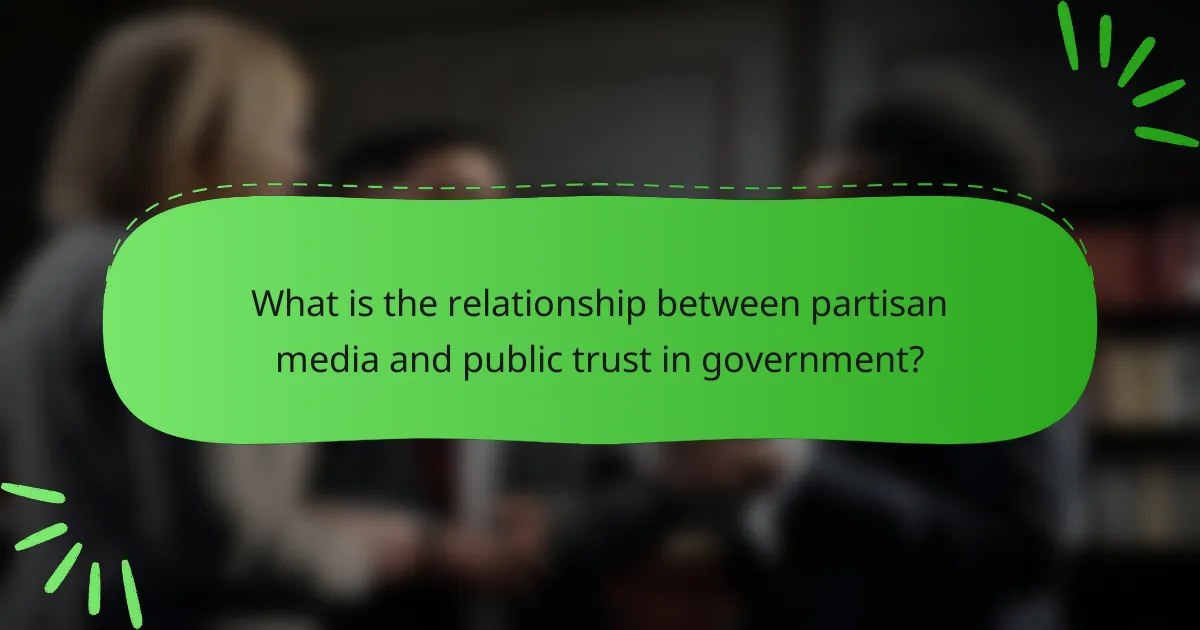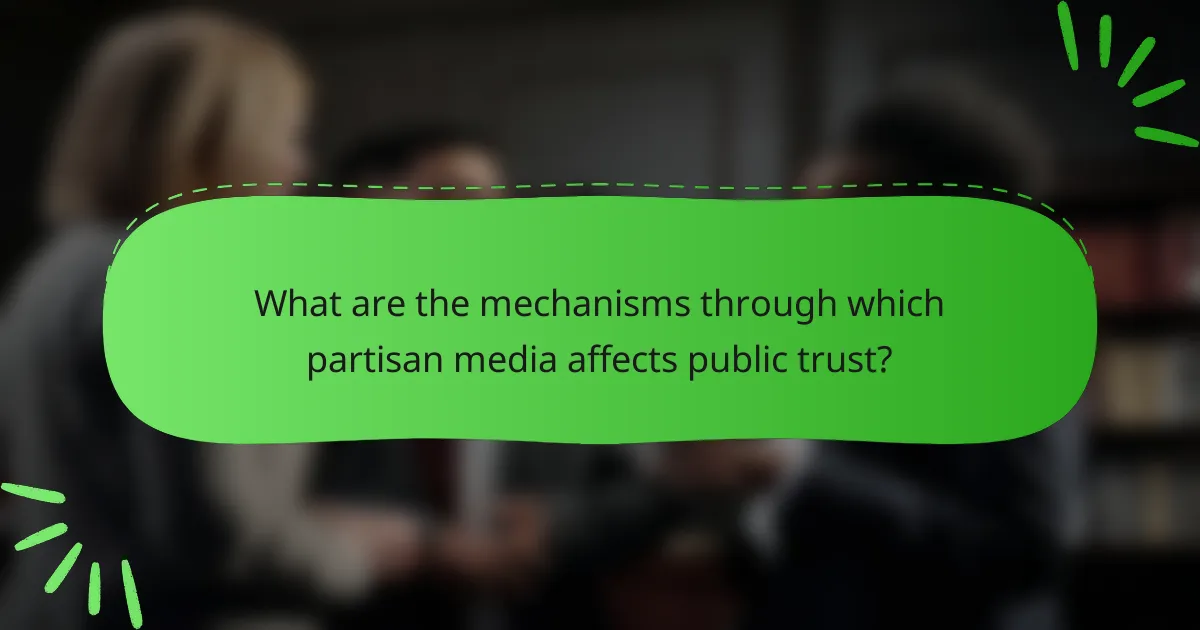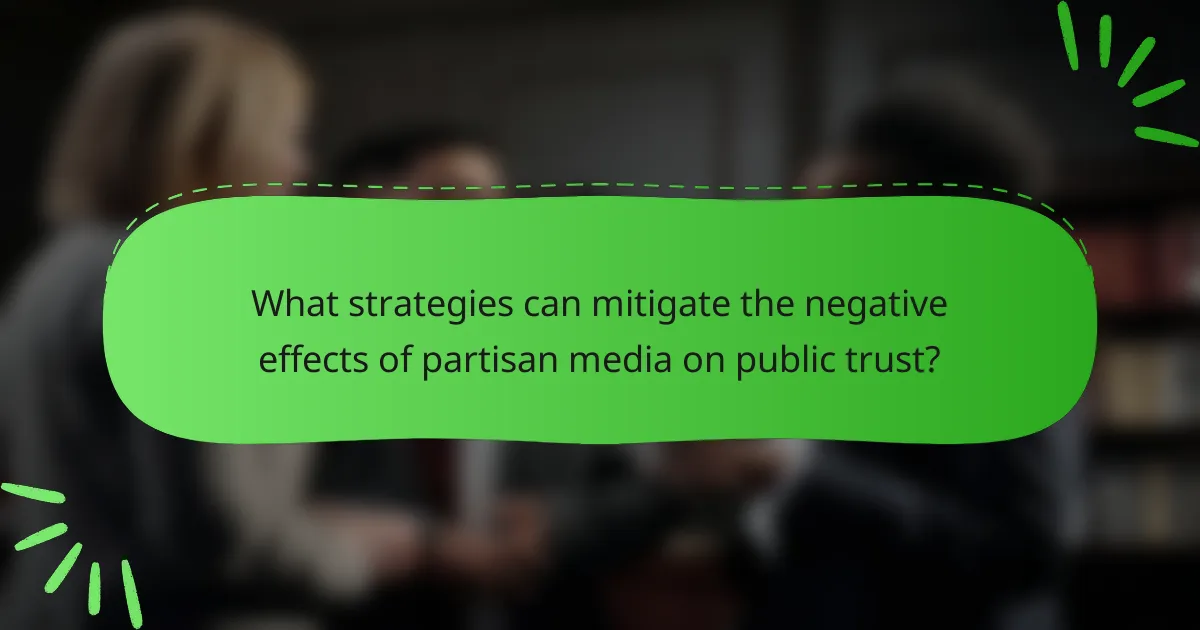Partisan media refers to news outlets that present information aligned with specific political ideologies, significantly influencing public trust in government institutions. Research indicates that exposure to partisan media leads to increased audience polarization, resulting in diminished trust in government. Key mechanisms include selective exposure, where individuals consume media that reinforces their beliefs; framing, which shapes perceptions of political figures and issues; and confirmation bias, where people accept information that aligns with their views while rejecting opposing evidence. The article explores the cyclical relationship between partisan media consumption and public trust, highlighting the importance of media literacy and diverse news consumption as potential solutions to mitigate these effects.

What is the relationship between partisan media and public trust in government?
Partisan media significantly affects public trust in government. Research indicates that exposure to partisan news can lead to increased polarization among audiences. This polarization often results in lower trust in government institutions. For example, a study by the Pew Research Center found that individuals who consume partisan media tend to have more negative perceptions of government. Furthermore, partisan media can reinforce existing beliefs, making individuals less likely to trust opposing viewpoints. This dynamic creates an environment where trust in government is contingent upon alignment with media narratives. Consequently, the relationship between partisan media and public trust in government is characterized by a cycle of distrust and polarization.
How does partisan media influence perceptions of government integrity?
Partisan media influences perceptions of government integrity by shaping narratives that align with specific political ideologies. This type of media often emphasizes negative aspects of government actions while downplaying positive outcomes. Research shows that individuals exposed to partisan media are more likely to distrust government institutions. A study by the Pew Research Center found that 62% of Americans believe news organizations favor one side in their reporting. This bias can lead to selective exposure, where individuals consume information that reinforces their preexisting beliefs. Consequently, perceptions of government integrity can become polarized, leading to increased skepticism among the public.
What role does media bias play in shaping public opinion?
Media bias significantly influences public opinion by framing issues in a way that aligns with specific ideological perspectives. This framing impacts how audiences perceive events and policies. Research shows that exposure to biased media can lead to polarization among viewers. For instance, studies indicate that individuals who consume partisan news are more likely to adopt extreme views. The Pew Research Center found that 62% of Americans believe news organizations are biased. This perception can erode trust in media and government institutions. Thus, media bias plays a critical role in shaping public discourse and opinion.
How do different media outlets contribute to partisan perspectives?
Different media outlets contribute to partisan perspectives by selectively framing news stories. They emphasize certain facts while downplaying others to align with specific political ideologies. For example, conservative outlets may highlight issues related to taxation and government spending, portraying them in a negative light for liberal policies. In contrast, liberal media might focus on social justice issues, presenting them as urgent and necessary.
Research shows that consumers often choose media that reinforces their existing beliefs. A Pew Research Center study indicates that 62% of Americans believe news organizations favor one side. This bias can lead to the reinforcement of partisan views and a polarized public. As a result, audiences may develop a skewed understanding of complex issues.
The choice of language and imagery also plays a crucial role. For instance, the portrayal of political figures varies significantly across outlets. This variation can shape public perception and influence political attitudes. Consequently, the media landscape contributes to the fragmentation of public discourse, fostering a divided society.
Why is public trust in government important?
Public trust in government is crucial for effective governance. It fosters cooperation between citizens and public institutions. High levels of trust can lead to increased civic engagement and compliance with laws. According to a 2020 study by the Pew Research Center, 75% of Americans believe that trust in government is essential for a functioning democracy. When citizens trust their government, they are more likely to support policies and initiatives. Conversely, low trust can result in political apathy and resistance to authority. Thus, public trust is foundational for social stability and effective policy implementation.
What are the consequences of low public trust in government?
Low public trust in government leads to decreased civic engagement. Citizens are less likely to vote or participate in public discussions. This disengagement can result in lower voter turnout, impacting election outcomes. Additionally, it fosters a culture of skepticism towards governmental policies. With diminished trust, people may resist compliance with laws and regulations. This can lead to increased social unrest and protests. Furthermore, low trust can hinder effective governance and policy implementation. Research indicates that countries with high trust levels experience better political stability and economic performance.
How does public trust affect civic engagement and participation?
Public trust significantly enhances civic engagement and participation. When citizens trust their government, they are more likely to vote, attend public meetings, and engage in community initiatives. Research indicates that high levels of public trust correlate with increased voter turnout. For instance, studies show that when trust in government is at 60%, voter participation can reach up to 75%. Conversely, low public trust leads to apathy and disengagement. A lack of trust often results in lower civic participation rates, with some surveys indicating a 30% drop in community involvement when trust is diminished. Thus, public trust is a crucial factor in fostering active civic participation.

What are the mechanisms through which partisan media affects public trust?
Partisan media affects public trust through selective exposure, framing, and confirmation bias. Selective exposure occurs when individuals choose media that aligns with their preexisting beliefs. This reinforces their views and diminishes trust in opposing perspectives. Framing influences how issues are presented, shaping public perception. For example, a partisan outlet may highlight negative aspects of a political figure while downplaying positive achievements. Confirmation bias leads individuals to accept information that confirms their beliefs while rejecting contradictory evidence. Studies show that partisan media consumption correlates with increased polarization and decreased trust in government institutions. Research by the Pew Research Center indicates that individuals who consume partisan media are less likely to trust news sources that present opposing viewpoints.
How does exposure to partisan media alter individual beliefs?
Exposure to partisan media significantly alters individual beliefs. It reinforces pre-existing biases and leads to polarization. Individuals often seek out media that aligns with their views. This selective exposure creates echo chambers. In these environments, opposing viewpoints are dismissed or devalued. Research shows that consistent exposure to partisan content can shift attitudes on key issues. For instance, a study by Levendusky (2013) found that individuals exposed to partisan media became more extreme in their political beliefs. This shift occurs because partisan media frames information in a way that supports specific narratives. Consequently, individuals may develop mistrust in alternative viewpoints and sources.
What psychological factors influence trust in government based on media consumption?
Cognitive biases and emotional responses significantly influence trust in government based on media consumption. Confirmation bias leads individuals to favor information that aligns with their pre-existing beliefs. This bias can reinforce distrust in government when partisan media presents negative narratives. Emotional responses, such as fear or anger, can also shape perceptions of government efficacy. For instance, sensationalist media may evoke strong emotions, leading to heightened skepticism.
Research by the Pew Research Center indicates that individuals consuming partisan media are more likely to distrust government institutions. This distrust is often correlated with the portrayal of government in a negative light. Additionally, social identity theory suggests that individuals identify with media that reflects their political views, further entrenching their trust or distrust in government.
Overall, these psychological factors create a feedback loop, where media consumption shapes perceptions of government, which in turn influences future media engagement.
How does confirmation bias reinforce partisan viewpoints?
Confirmation bias reinforces partisan viewpoints by causing individuals to favor information that aligns with their existing beliefs. This bias leads people to seek out, interpret, and remember information that supports their political preferences. Research shows that individuals exposed to partisan media are more likely to accept biased information as truth. A study by the Pew Research Center found that 62% of Americans prefer news that aligns with their political views. This selective exposure further entrenches partisan beliefs and reduces the likelihood of engaging with opposing viewpoints. Consequently, confirmation bias contributes to increased polarization within political discourse.
What evidence exists to support the effects of partisan media on trust?
Partisan media significantly affects public trust in government. Research indicates that exposure to partisan news sources can lead to increased polarization. A study by the Pew Research Center found that individuals who primarily consume partisan media report lower levels of trust in government institutions. Specifically, 68% of those who favor partisan outlets express distrust in the federal government. Additionally, a study published in the journal “Political Communication” found that viewers of partisan media are more likely to perceive bias in news reporting. This perception contributes to a decline in trust towards the media and government. Overall, evidence suggests that partisan media fosters skepticism and diminishes trust in government entities.
What studies highlight the correlation between media consumption and trust levels?
Several studies highlight the correlation between media consumption and trust levels. One significant study is “The Partisan Press: The Media’s Role in the Erosion of Public Trust” by Pew Research Center. This research indicates that individuals consuming partisan media exhibit lower trust in government institutions. Another relevant study is “Media Use and Trust in Government” by the American Political Science Review. It found that exposure to biased news sources correlates with decreased trust in political leaders. Additionally, “Echo Chambers and Trust: How Media Consumption Shapes Political Attitudes” by the Journal of Communication shows that people who engage with homogeneous media environments tend to have diminished trust in opposing viewpoints and government. These studies provide concrete evidence of the impact of media consumption on trust levels in government.
How do surveys reflect changes in public trust over time?
Surveys reflect changes in public trust over time by measuring perceptions of government actions and media influence. They capture data on public opinions at specific intervals. This data can show trends, revealing increases or decreases in trust. For example, surveys conducted during political events often highlight shifts in trust levels. Historical data, like the Pew Research Center’s surveys, demonstrate how trust in government fluctuates with media coverage. In the 2008 financial crisis, surveys indicated a significant drop in trust due to negative media portrayal. Thus, surveys serve as a barometer for public sentiment regarding government and media interactions.

What strategies can mitigate the negative effects of partisan media on public trust?
Promoting media literacy can mitigate the negative effects of partisan media on public trust. Media literacy empowers individuals to critically analyze news sources. Educational programs can enhance understanding of media biases. Encouraging diverse news consumption fosters exposure to multiple viewpoints. Fact-checking initiatives can help verify information accuracy. Supporting independent journalism strengthens trust in reliable reporting. Engaging community discussions can bridge divides and enhance dialogue. Research shows that informed citizens are less susceptible to misinformation.
How can individuals critically evaluate media sources?
Individuals can critically evaluate media sources by assessing their credibility and bias. First, check the author’s qualifications and expertise in the subject area. Reliable sources often have transparent authorship and credentials. Next, analyze the publication’s reputation. Reputable outlets adhere to journalistic standards and fact-checking processes.
Additionally, identify potential bias in the content. Consider the language used and the framing of issues. Sources with extreme language or one-sided perspectives may indicate bias. Furthermore, cross-reference information with other credible sources. This helps verify the accuracy of the claims made.
Lastly, examine the source’s funding and ownership. Outlets funded by specific interest groups may present skewed information. Studies show that awareness of media bias can enhance critical evaluation skills. For example, research by the Pew Research Center highlights that individuals who understand media bias are more discerning consumers of news.
What best practices should be adopted for media literacy?
Best practices for media literacy include critical evaluation of sources. Individuals should verify the credibility of information before sharing it. This involves checking the author’s qualifications and the publication’s reputation. Understanding bias in media is also essential. Consumers must recognize the difference between opinion pieces and factual reporting. Engaging with diverse viewpoints enhances perspective and reduces echo chambers. Teaching media literacy in educational settings can empower future generations. Studies show that informed individuals are less susceptible to misinformation. For example, a 2020 report from the Stanford History Education Group found that students who received media literacy instruction demonstrated improved critical thinking skills.
How can diverse media consumption improve public trust?
Diverse media consumption can improve public trust by exposing individuals to a variety of perspectives. This exposure reduces the likelihood of echo chambers that reinforce biases. It allows people to critically evaluate information from multiple sources. Research shows that individuals who consume diverse media are more informed about political issues. A study by the Pew Research Center found that 62% of those who engage with diverse media feel more confident in their understanding of current events. This increased understanding fosters trust in institutions and media. Trust is built when individuals see balanced reporting and varying viewpoints. Ultimately, diverse media consumption encourages informed public discourse, leading to greater trust in government.
What role do policymakers play in addressing media partisanship?
Policymakers play a critical role in addressing media partisanship. They can implement regulations that promote transparency in media ownership. This transparency can help the public understand potential biases in news sources. Additionally, policymakers can support initiatives that encourage media literacy among citizens. Improved media literacy enables individuals to critically evaluate news content. Policymakers can also advocate for diverse media funding to reduce reliance on partisan sources. Research indicates that increased funding for public broadcasting can enhance impartial news coverage. By fostering an environment that values balanced reporting, policymakers can mitigate the effects of media partisanship on public trust in government.
What initiatives can be implemented to promote balanced media reporting?
Implementing media literacy programs can promote balanced media reporting. These programs educate the public on identifying bias and evaluating sources. Training journalists in ethical reporting standards also fosters objectivity. Encouraging diverse newsroom staff enhances representation of multiple perspectives. Establishing independent media watchdog organizations can hold outlets accountable. Promoting transparency in funding sources of media organizations builds trust. Collaborative reporting initiatives between outlets can provide comprehensive coverage of issues. Research shows that diverse media environments increase public trust in information sources.
How can transparency in government communications enhance trust?
Transparency in government communications enhances trust by providing clear and accessible information to the public. When citizens receive consistent and open communication, they feel more informed about government actions. This openness reduces misinformation and speculation, which can erode trust. Research indicates that transparency fosters accountability. For instance, a study by the Pew Research Center found that 70% of Americans believe that transparency in government is crucial for trust. Furthermore, transparent communication can lead to increased public engagement. When citizens feel informed, they are more likely to participate in civic activities. Overall, transparency serves as a foundation for building and maintaining public trust in government.
What practical steps can citizens take to foster trust in government despite partisan media?
Citizens can take several practical steps to foster trust in government despite partisan media. First, engaging in open dialogue with diverse community members can bridge understanding. This can involve attending town hall meetings or community forums. Second, citizens should seek out multiple news sources to gain a well-rounded perspective. Research shows that consuming a variety of viewpoints can reduce biases. Third, participating in civic activities, such as volunteering for local organizations, can enhance community ties. This involvement can create a sense of shared responsibility and trust. Fourth, advocating for transparency in government operations helps build accountability. Citizens can support initiatives that promote open access to information. Lastly, educating oneself about government processes fosters informed discussions. Knowledgeable citizens are better equipped to challenge misinformation. These steps collectively contribute to a more trusting relationship between citizens and their government.
The primary entity of this article is partisan media and its effects on public trust in government. The article examines how exposure to partisan media influences public perceptions of government integrity, leading to increased polarization and decreased trust in government institutions. It highlights the mechanisms through which partisan media operates, including selective exposure, framing, and confirmation bias, and discusses the consequences of low public trust, such as decreased civic engagement. Additionally, the article explores strategies for mitigating the negative effects of partisan media, emphasizing the importance of media literacy, diverse media consumption, and transparency in government communications to foster public trust.